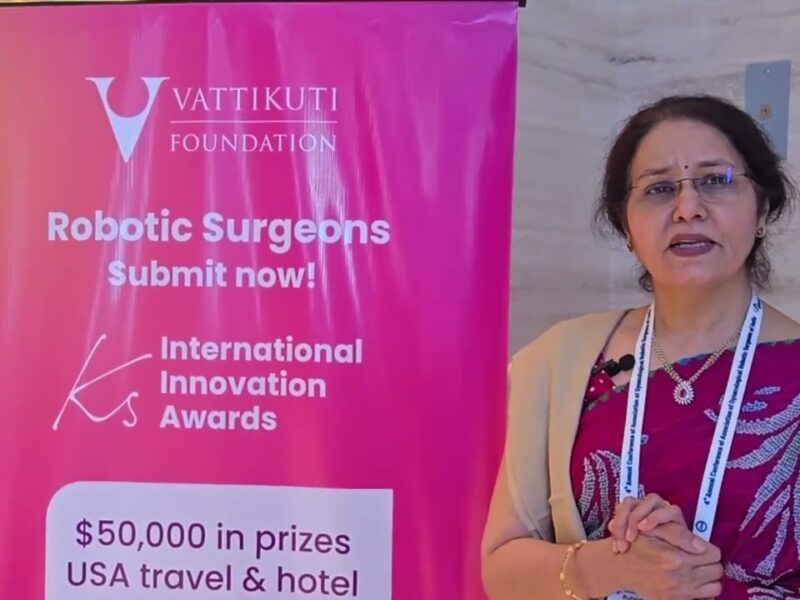Fluorescence based Surgery – Lighting up the pathway for Robotics
NOTE: SCROLL DOWN THROUGH ABSTRACT TO ACCESS THE VIDEO.
This video, produced by Submitted by – Dr. Abhinav Y.Deshpande ( Vattikuti Fellow at Manipal Hospital, Bangalore, India ) under Mentorship of Dr. Somashekhar SP, was a Finalist in the KS National Robotic Surgery Video Awards at the December, 2018 Robotic Surgeons Council of India meeting. Here is the Abstract:
Topic- ‘Fluorescence based Surgery – Lighting up the pathway for Robotics !’
Background-
Robotics has indeed come up a long way in terms of application of the ever-changing technology and amalgamating the same for the advances in performing surgery. All the domains concerning the optimal and safe performance of surgery like visual, haptics, precision , dexterity have been continuously addressed. One landmark discovery was the incorporation of the Fluorescence detection ( Firefly ) in the robotic system. This has taken the visual sense of the surgeon to a different level altogether, which is helping the surgeon to localize the target tissue with utmost clarity. Since the time of introduction of the system X at our institute, we have been studying and exploring the myriad applications of this new exciting technology. Various other modalities are also being tried to be imbibed in the robotic system. We would like to present our results as well as the scope of application of Fluorescence.
Methodology-
We carried out 2 different studies based on ICG related Firefly technology in patients presenting to us at Manipal comprehensive cancer Centre, Bangalore. Patients presenting with Endometrial Cancers in Gynae-Onco Group and patients presenting with Rectal and Colonic malignancies in the Colorectal Onco group. The study was carried out prospectively for a period of 6 months from February 2018 to July 2018. Ethics committee approval was taken and patients informed regarding the ICG & consent taken. For the Gynae-Oncology group , ICG solution was prepared by mixing the 25 gm. of Aurogreen with 20 cc of distilled water and a concentration of 1.25mg/ml was obtained. We used the Insulin syringes to inject 1 cc of prepared ICG solution at 3 and 9o clock position in the cervix. V- Care was then inserted and docking done. After instrument insertion, Firefly mode was turned on and the Lymph nodes, which showed Fluorescence, were noted depending on the location and excised and sent for frozen section. Depending upon the frozen report, completion lymphadenectomy was done. For the colorectal onco group, ICG was diluted with 10 cc of distilled water i.e. a concentration of 2.5 mg/ml. 3 cc is given bolus via a central or peripheral line and the Firefly mode turned on to look for the delineation of ICG indicating the vascularity. We marked the clinically probable site of transection, and then after giving the ICG, the site of transition noted and record maintained.
Observations & Results-
In terms of the Endometrial cancer , by the Firefly mode:
• Sentinel Node Detection Rate : 100%
• Bilateral nodal Detection Rate : 95%
• Paraaortic nodal Detection Rate : 30%
• Lymph node Positivity : 0.5%
• Sensitivity of the test : 100%
• The mean time ±SD to identify the nodes : 32.95 ± 10.5minutes
Also the distribution of the sentinel lymph nodes in terms of its frequency of distribution in the pelvic and the paraortic region was charted
For Gynaec-Onco
•ICG based localization of SLN in endometrial cancer is technically feasible and identified unilaterally in 100% of patients and bilaterally in 95% of patients.
• The cervical injection at 3 and 9 o clock has shown a detection rate of 100%
• This avoid unnecessary lymphadenectomy in 95% of patients.
• ICG identifies the route of spread of endometrial cancer and real sites of possible metastasis (sentinel nodes)
• This is a safe alternative to standard lymphadenectomy and its related complications and can be considered as standard of care.
For Colorectal Onco
• ICG identified the line of transection in rectal cancers with authenticity in 100% of patients.
• Un necessary splenic flexure mobilization and resection of excess sigmoid colon could have been avoided in 76.9% of patients
• Anastomotic failure could have resulted in 7.6% of patients if anastomosis has been done by clinical judgement alone.
• This can identify the vascular segment of bowel real time and there by provides safe anastomosis
Other Uses of ICG in Robotics
-ICG via intravenous route in 2.5mg/ml concentration was also given for cases of partial nephrectomies to know the status of vascularity of kidney.
– ICG can identify the biliary system and help in identifying the cystic ducts during complex hepatobiliary resections.
-ICG given through cystoscopic ureteric catheterization ,can be used to identify Ureters
-ICG can be used in thoracic surgeries and esophagectomies for identification of thoracic duct
-ICG can also be used for identifying vascularity in ileal conduit after radical cystectomy
-In pancreatic surgery also ICG has found out its application in delineating the tumour
Conclusions
Fluorescence based surgery is fast picking up in robotics and has got tremendous potential ICG based surgery by robots has established its firm foothold and has approved indications. The use of Firefly in Gynaec-onco and colorectal onco was able to produce superior results. In terms of Sentinel node identification thus avoiding the morbidity associated with the complete lymphadenectomy. In terms of colorectum , it was able to give a better line of transection which was healthy & vascular thus decreasing the risk of anastomotic leaks. Also at other places, there are expanding indications of Firefly technology. Besides, other new fluorescent agents as well as surgical systems are also being investigated upon, which definitely would open up a mountain of possibilities. Currently, we are just at the tip of iceberg, still lot of hidden treasure lies beneath!!. Narrated robotic surgery video, with PPT’s, surgical footage, photos, diagrams, 07:51
Date
August 15, 2020






